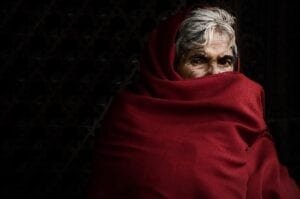A Retelling of the Golden Calf
Moses has gone upon the mountain to be with God. There he receives instruction about how God’s people are to carry themselves. About how they are to love God, how they are to love their neighbors, and even instructions about loving the stranger. From the very beginning when God promised Abraham that he would make his people as numerous as the stars in the sky, God’s people were to be a nation that existed not just to receive the blessing of God, but to also be a nation that existed to bless the world.
But while Moses was on the mountain with God, God’s people had grown restless in wait. It had been weeks that Moses had been gone and at this point people feared the worst. They believed that Moses was never coming back. So they began pressuring Aaron to make them a god who would continue to lead them. An idol that would represent the God who delivered them out of Egypt.
Aaron gives in to the pressure and slowly begins crafting a Golden Calf, telling the people to go gather their gold. And then Aaron takes his time building an alter. Moses still hasn’t show up so after taking the time to melt gold, to cast an idol, to build an alter, and to delay the people from completely go wild, he tells the people that tomorrow they’ll celebrate a festival to God with this alter and this golden calf. The evening comes, and then the morning, but still no Moses. So the people begin to celebrate around this new likeness they had crafted, twisting God in a way to make them feel like God was still with them.
And of course this angered God. The people were turning to a likeness of God instead of God himself. They had turned to a manufactured god that represented the God who brought them out of Egypt, but this likeness of God crafted by human hands could never bring them life. Only God could do that and in turning towards the Golden Calf, the people had turned away from God not realizing what they had truly done.
And both Moses and God’s anger burned because of what was happening. Because the people had turned away from God, they had brought destruction upon themselves. God was angry about this and so was Moses. Moses knowing they would perish because of what they had done, begins pleading with God to spare them. But God tells Moses to leave him alone so that his anger could burn against them. God even tells Moses that he is willing to make him the new Abraham.
And as tempting as this offer was, to be the one known as the father of a nation that would receive God’s blessing and then extend that blessing to the rest of the world, Moses says no and begins pleading with God to show them mercy. Moses was choosing to stand in the breach between a corrupt people and a righteous God, even at his own cost, giving up an incredible offer that God had made him.
Because of Moses’ prayers, God relents and chooses to continue leading the people to the promised land extending forgiveness to them. It was a moment sealed in time that would point to a future moment in history. God would enter the world as Jesus, and choose to stand in the breach much like Moses did. He would even take on the suffering of the people, choosing to take on even death itself to prove that his of love and forgiveness was more powerful than the un-relinquishing grip of even death itself.
Jesus, God in the flesh, would stand in the breach, and proclaim over those killing him, “Father forgive them because they don’t know what they’re doing.” And like Moses, it would be Jesus standing in this gap that showed people the unending mercy and love of God.
More Resources on the Golden Calf
Psalm 106:23 – So he said he would destroy them—had not Moses, his chosen one, stood in the breach before him to keep his wrath from destroying them.
Storyline Commentary on Exodus 32:1-14
Every story can be broken down into a few parts. The setting, where the story takes place and why it might be important. The characters and their emotions and thoughts invested in the story. A tension that needs resolved. A resolution that brings us through the tension, and a through line (aka main idea) that carries the story through from beginning to end.
The Setting The people have been delivered out of Egypt. Moses has been on the mountain speaking with God and it is past due time for him to be back and this is causing the people to become anxious.
The Characters
- Moses on the mountain speaking to God.
- Aaron overwhelmed by the people.
- The people who want a representation of God but that’s false.
- God who changes his mind in this story, transitioning from wrath to mercy.
The Tension The people have grown anxious and are afraid Moses is never coming back. The one who led them out of Egypt is missing in action and they want a god who represents the one who brought them out of Egypt so they pressure Aaron for a god who will go before them. Aaron casts an image of God in the form of a golden calf based on the peoples gold and draws out a time of preparation and alter building that will be a celebration to the God who brought them out of Egypt, presumptuously to draw out time for Moses to return.
The Resolution Moses does return, and when he sees that the people are worshipping a false image of God, that they have given their allegiance to an image that doesn’t actually represent God, he smashes the tablets given to him by God. It was an act of mercy on behalf of Moses because he then begins to plead with God for mercy on behalf of the people, even turning down God’s offer to make him like Abraham. Moses is choosing to stand in the gap for a people who have no real idea of what they’re doing and pleading for their forgiveness, much like Jesus stood in the gap, forgiving those who knew not what they were doing.
The Through Line It is praiseworthy to stand in the gap for those who sin, even when it is egregious.
Reflections on the Golden Calf
Why has this story endured? Everything about God delivering the people could have been undone in this moment. But because Moses was willing to turn down being a new Abraham and plead on behalf of the people, God relents of his burning anger against them and offers mercy instead. God continues to be the Deliverer. In a strange twist of events, because Moses focused on the people, it pleased God. Aaron doesn’t the reverse. Aaron focuses on God so much, that he leads the people astray by casting for them a false image of God. This is a defining moment that nothing manmade truly represents God. God is God and anything we craft is not, even if we’re like Aaron, crafting something to represent God so people will celebrate God, instead of pointing people towards God who can’t be imagined with human hands.
What is true for them then that is still true for us today? This story often gets told as the people worshipping a false God. That’s not really what’s happening here. The people are worshipping a false image of the God who delivered them out of Egypt. We craft ideas and systems that we think are representative of God and then give our allegiance to those ideas and systems as a proxy to God. in 2020 United States of America, we have done that with politics. Many have given their allegiance to American politics as proxy to praising God but politics has become a false image of God. But this isn’t the only point of this story. What’s true today that was true back then, is that we can still stand in the gap, offering forgiveness to those who don’t know what they’re doing, much like Moses. And like Moses, that sometimes means turning down our own gain in order to do so.
How does this story help us love God? This is a story of God responding to prayer. I believe God still responds to prayer. We often think of prayer being this idea of asking God to answer our prayers and sometimes prayer, and probably oftentimes, prayer is a way of aligning ourselves with God. This is what Moses does in this story. Moses aligns himself with the God he knows from Egypt, calling to remembrance, all of the good things God has done and calling on promises that were made. We can continue to respond to those promises, namely that God loves us so much, that he sent Jesus into this world to be a sacrifice for our sins, so we could accept mercy.
How does this story help us love others? It’s a call to stand in the gap. It’s easy to ridicule and tear down. It’s harder to stand in the gap for those who sin, especially when it seems so blatant, but that’s the story of the prophets, that’s the story of Moses. It’s the story of Jesus who prayed over the people, “forgive them because they don’t know what they do.”










